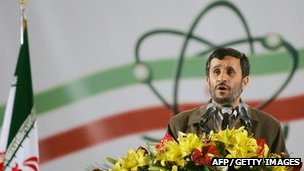
Not all is doom and gloom. Somewhat contrary to initial expectations, Russia and China joined in a firm new IAEA resolution, again calling upon Tehran to come completely clean. The UK and France are pressing European foreign ministers to adopt an oil embargo, joining the United States, and while that is not likely to have much material effect on Iran’s ovefrall export prospects, ratcheting up pressure is more likely to help than hurt at this stage of the game.
Most importantly, there have been no unilateral military strikes, and though the Obama administration continues to insist all options are on the table, it also is signaling it would not take preemptive military action absent a broader consensus in its favor.
An administration official told Arms Control Today, as quoted in the issue that went live online today, that “it will not be the United States or any other national government that judges if Iran has done what it needs to do” to resolve concerns about its past activities. The IAEA “can give Iran a clean bill of health so long as Iran commits to genuine cooperation.”
The news report in which that quotation is embedded, by Peter Crall, does an admirable job of describing at length the contents of the IAEA’s report on Iran that contained revelations about its nuclear weaponization efforts. Separately, on Friday, the Arms Control Association posted a commentary and analysis of the report by Greg Thielmann and Benjamin Loehrke.
At risk of belaboring the question of how new the IAEA’s findings are, let me comment briefly. Thielmann and Loehrke argue that the IAEA report is “remarkably consistent” with a 2007 U.S. intelligence finding in which it was said “with moderate confidence” that Tehran had “not restarted its nuclear weapons program as of mid-2007.” But in two key paragraphs that they do not quote in full, the IAEA makes quite clear its belief that some important elements of the weaponization program never fully stopped, that some likely continue, and that the same person who was in charge before 2003 probably still is in charge today.
For the record, of the analyses and commentaries on the IAEA report that I have seen, in my opinion only the analysis by David Albright’s ISIS–which my fellow blogger Jodi Lieberman was quick to flag–adequately reported the gist of those two paragraphs. (I mention that partly because Thielmann and Loehrke are very critical of the way we people in the press have covered the report, and because David Albright’s special relationships in the press and with the IAEA are so widely resented.)
To put the significance of those paragraphs in perspective, consider what the impact would have been had it been discovered in the 1950s or 1960s that West Germany had an active nuclear weapons design program. Everybody knew of course that Germany was determined to master the fuel cycle and develop fuel cycle facilities to the extent it could; no top-ranking economic power could afford to be without the wherewithal to open the nuclear weapons option, should somehow the need arise. The two superpowers were able to agree on the 1970s Nonproliferation Treaty primarily because both wished–along with all their wartime allies–to constrain and channel Germany’s ambitions.
Had it been revealed under those conditions that Germany was not just acquiring fuel-cycle technology but actually designing and developing nuclear weapons, this would likely have been considered a possible casus belli by the Soviet Union–and quite possibly not just by the Soviet Union!
So, to sum up, what was substantively new about the IAEA’s report was its finding that Iran was not merely trying to “open” the nuclear option by obtaining a nuclear fuel cycle but was actively developing a nuclear weapon and warhead (as I have emphasized repeatedly here). What was procedurally new, as Jodi has rightly emphasized, was the IAEA’s new willingness to put its imprimatur on that finding and go public with it.
Consider now what former IAEA chief Mohamad ElBaradei had to say about Iran’s nuclear weaponization efforts in the major book published less than six months ago. By February 2008, when ElBaradei was working frantically once again to break the deadlock between the P-5+1 negotiating countries and Iran, he was well aware of allegations about Iran’s bomb design efforts. “The problem was, no one knew if any of this was real.” U.S. intelligence provided information that it said came from a laptop obtained in 2004 but would not reveal the source of the laptop, turn over the actual documents or provide corroborating evidence.
When ElBaradei pressed Iran to address the allegations, shortly before the IAEA was to issue its May 2008 report, Iran offered access to individuals and information–but only if the IAEA promised to give it a clean bill of health in advance! “This was ludicrous,” as ElBaradei comments.
In June 2008, IAEA safeguards chief Olli Heinonen gave a technical briefing to board members in which he said the agency had now obtained corroborating information on the weaponization issue from ten countries. Mentioning a “uranium metal” document–read advanced atomic bomb design–that he said Iran apparently had obtained from the A.Q. Kahn network, Heinonen used the word “alarming.”
So yes, the allegations about Iran’s nuclear weaponization efforts are not new. But following that June 2008 briefing, it took the IAEA three more years to satisfy itself that the charges were credible. Or, if you prefer, it took the IAEA three years to find the courage to air them.
Whichever it was, what it finally did is important.